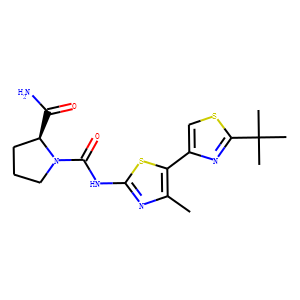| InChI | InChI=1S/C17H23N5O2S2/c1-9-12(10-8-25-14(20-10)17(2,3)4)26-15(19-9)21-16(24)22-7-5-6-11(22)13(18)23/h8,11H,5-7H2,1-4H3,(H2,18,23)(H,19,21,24)/t11-/m0/s1 |
| Reference | 1. Appl Microbiol Biotechnol. 2007 Oct;76(5):1137-44. Epub 2007 Jul 12. <br />
Inhibition of Vibrio biofilm formation by a marine actinomycete strain A66. <br />
You J(1), Xue X, Cao L, Lu X, Wang J, Zhang L, Zhou S. <br />
Author information: <br />
(1)State Key Laboratory for Biocontrol, College of Life Sciences, Sun Yat-Sen
University, Guangzhou, 510275, People/’s Republic of China. <br />
China remains by far the largest aquaculture producer in the world. However,
biofilms formed by pathogenic Vibrio strains pose serious problems to marine
aquaculture. To provide a strategy for biofilm prevention, control, and
eradication, extracts from 88 marine actinomycetes were screened. Thirty-five
inhibited the biofilm formation of Vibrio harveyi, Vibrio vulnificus, and Vibrio
anguillarum at a concentration of 2.5% (v/v). Thirty-three of the actinomycete
extracts dispersed the mature biofilm. Six extracts inhibited the quorum-sensing
system of V. harveyi by attenuating the signal molecules N-acylated homoserine
lactones/’ activity. Strain A66, which was identified as Streptomyces albus, both
attenuated the biofilms and inhibited their quorum-sensing system. It is
suggested that strain A66 is a promising candidate to be used in future marine
aquaculture. <br />
2. Plant Physiol. 1989 Apr;89(4):1337-40. <br />
Compensation for a Mutated Auxin Biosynthesis Gene of Agrobacterium Ti Plasmid
A66 in Nicotiana glutinosa Does Not Result from Increased Auxin Accumulation. <br />
Campell BR(1), Su LY, Pengelly WL. <br />
Author information: <br />
(1)Department of Chemical and Biological Sciences, Oregon Graduate Center,
Beaverton, Oregon 97006-1999. <br />
Nicotiana glutinosa compensated for a mutated tumor-morphology-shooty (tms)
(auxin biosynthesis) locus of Agrobacterlum tumefaciens strain A66 and showed the
same virulent tumor response to infection by strain A66 or the wild-type strain
A6. Cloned cell lines transformed by strains A6 or A66 were fully hormone
independent in culture and grew rapidly as friable, unorganized tissues on
hormone-free growth medium. Growth of N. glutinosa tumor cells was inhibited by
addition of alpha-naphthaleneacetic acid to the growth medium, and A6- and
A66-transformed cells showed similar dose responses to this auxin. On the other
hand, A6-transformed cells contained much higher levels of indole-3-acetic acid
(IAA) and 1-aminocyclopropane-1-carboxylic acid (ACC) than A66-transformed cells.
Differences in IAA and ACC levels in N. glutinosa tumor lines were consistent
with the expected activity of the tms locus and were quantitatively similar to
results obtained previously with A6- and A66-transformed cells of Nicotiana
tabacum, which does not compensate for mutated tms genes. Thus, compensation for
mutated tms genes in N. glutinosa did not result from increased auxin
accumulation and did not appear to be related to the capacity of this host for
auxin biosynthesis.
3. Cell. 1982 Dec;31(3 Pt 2):605-12. <br />
Variation in hormone autonomy and regenerative potential of cells transformed by
strain A66 of Agrobacterium tumefaciens. <br />
Binns AN, Sciaky D, Wood HN. <br />
Mutant Agrobacterium tumefaciens strain A66 is shown to differ from its wild-type
progenitor (strain A6) by a spontaneous 2.7 kb DNA insert into the T-DNA region
of its Ti plasmid. Tobacco stems transformed by A66 exhibit an attenuated
response characterized by slow growth and shoot proliferation. Clonal analysis
demonstrates that this response is due to an alteration in the growth and
regenerative potential of transformed cells, rather than to variation in the
frequency of fully autonomous cells within the primary tumor. Cloned A66
transformed tobacco cells exhibit an auxin requirement for growth that can be
overcome by shoot proliferation. Other host species, however, may complement the
A66 mutation yielding fully auxin-independent tumors when transformed by this
bacterium. <br />
|

